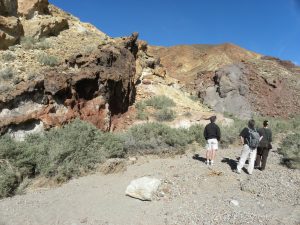Deserts are such dry places that when the rain does come it can have dramatic effects. Desert soil sheds water quickly, and there are relatively few plants to retard runoff. The result is often a flash flood. Here is a NOAA page on predicting flash floods, not all of which are in deserts (thanks in part to deforestation), and here is a NOAA page where you can get the latest flash flood warnings by zipcode. And please, young geologists, never end up in a narrow canyon during a flash flood.
Alluvial fans and debris cones are dramatic water-formed features, and they are well displayed in deserts. They are characterized by their fan shapes (they’re really deltas on land) and poorly-sorted sediments.
On our field trip we will see that wadis (also known as arroyos, washes, or dry river beds) will be our pathways into the desert wilderness. Here’s a USGS page about wadi (wash) development in the Mojave. Note how important it is to understand past climate conditions and geomorphology before interpreting present geomorphic features. This is especially true for the Mojave River, which you will soon get to know well.
Want to see beautiful photographs of Death Valley? They are very cool, as are these. Here’s to sunshine, flowers, and rocks as far as you can see!
Speaking of desert water, I just found a series of blog posts on the recent history of Zzyzx. It is a good introduction to Curtis Howe Springer. You can also check out the Wikipedia entry on Rev. Springer.
Here’s an extinct South American rodent that was the size of a buffalo and had incisors that could inflict some serious damage. Josephoartigasia monesi was a kind of monster guinea pig. Impressive.
This short BBC time-lapse film of the Vermillion Cliffs in Arizona is beautiful and soothing. You’ll also see superposition, dune cross-bedding in a Jurassic sandstone, entrenched meanders, and a stunning starry confirmation of the Earth’s rotation.
Could there now be “hundreds of billions of Earth-like planets in our galaxy which might support life”? The numbers of detected exoplanets is now in the thousands, enough so that some astronomers can suggest that most stars have planets. It’s not feeling so lonely any more.

